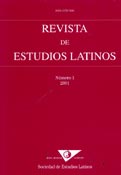Sensibilidad senequista en la estructura de desorden de Titus Andronicus
DOI:
https://doi.org/10.23808/rel.v5i0.87923Palabras clave:
Sensibilidad senequista; estructura de desorden; fragmentación.Resumen
En 1927, T. S. Eliot destaca la presencia de Séneca en el drama isabelino con la intención de descubrir los mecanismos teatrales de lo que él llama «la penetración de la sensibilidad senequista» en la producción de Shakespeare. El presente artículo retoma las palabras de Eliot y pretende descubrir las estrategias dramáticas a través de las cuales dicha sensibilidad senequista refuerza la propia estructura de Titus Andronicus; una estructura que está dominada por la hegemonía del desorden.
Descargas
Citas
H. BAKER, Induction to Tragedy, Louisiana State 1939.
T. W. BALDWIN, William Shakspere’s Small Latin & Lesse Greeke, Urbana 1944.
J. BATE (ed.), Titus Andronicus, London and New York 1995.
——, Shakespeare and Ovid, Oxford 1998.
C. BELSEY, «Senecan Vacillation and Elizabethan Deliberation: Influence or Confluence?», Renaissance Drama (1973), pp. 65-88.
M. C. BRADBROOK, Theme and Conventions of Elizabethan Tragedy, London 1935 (1990).
R. BROUDE, «Vindicta Filia Temporis: Three English Forerunners of the Elizabethan Revenge Play», JEGP 72 (1973), pp. 493-501.
R. BROWER, Shakespeare and the Graeco-Roman Heroic Tradition, Oxford 1971.
H. B. CHARLTON, The Senecan Tradition in Renaissance Tragedy, Manchester 1921 (1946).
M. CEREZO MORENO, «The Dissected Body: Fascination and Horror on the Elizabethan Stage», Actas del XXVI Congreso de Aedean. Fifty Years of English Studies in Spain (1952-2002). A Commemorative Volume, Santiago de Compostela, 2003, pp. 483-89.
W. CLEMEN, English Tragedy Before Shakespeare, London 1961.
T. W. CRACK (ed.), Gorboduc. Minor Elizabethan Tragedies, London 1974.
J. W. CUNLIFFE, The Influence of Seneca on Elizabethan Tragedy, London 1893.
T. S. ELIOT, «Shakespeare and the Stoicism of Seneca», Shakespeare Association Publications, London 1927, pp. 11-17.
G. L. EVANS, «Shakespeare, Seneca and the Kingdom of Violence», T. A. Dorey and D. R. Dudley (eds.); Roman Drama, London 1965, pp. 122-59.
W. FARNHAM, The Medieval Heritage of Elizabethan Tragedy, Oxford 1970.
A. C. HAMILTON, The Early Shakespeare, California 1967.
A. HUGHES (ed.), Titus Andronicus, Cambridge 1994.
G. K. HUNTER, «Seneca and the Elizabethans: A Case-Study in “influence”» (1967), Dramatic Identities and Cultural Tradition. Studies in Shakespeare and his Contemporaries. Critical Essays, Liverpool 1978, pp. 159-73.
——, «Seneca and English Tragedy» (1974), Dramatic Identities and Cultural Tradition. Studies in Shakespeare and his Contemporaries. Critical Essays, Liverpool 1978, pp. 174-213.
P. INGBERG (trad.), Tito Andrónico, Losada 2004.
E. JONES, The Origins of Shakespeare, Oxford 1977.
G. M. KENDALL, «“Lend me thy hand”: Metaphor and Mayhem in Titus Andronicus», Shakespeare Quarterly 40 (1989), pp. 299-316.
N. C. LIEBLER, «Getting it all right: Titus Andronicus and Roman History», Shakespeare Quarterly 45 (1994), pp. 263-78.
F. L. LUCAS, Seneca and Elizabethan Tragedy, Cambridge 1922.
A. M. MARTÍN RODRÍGUEZ, Fuentes Clásicas en Titus Andronicus de Shakespeare, León 2003.
J. C. MAXWELL (ed.), Titus Andronicus, London and New York 1953 (1987).
S. X. MEAD, «The Crisis of Ritual in Titus Andronicus», Exemplaria: A Journal of Theory in Medieval and Renaissance Studies 6.2. (Fall 1994): 459-79.
H. METZ, «The Early Staging of Titus Andronicus», Shakespeare Studies XIV (1981), pp. 99-109.
R. S. MIOLA, Shakespeare’s Rome, Cambridge 1983.
——, Shakespeare and Classical Tragedy. The Influence of Seneca, Oxford 1992.
A. L. MOTTO y J. R. CLARK, «Senecan Tragedy: A Critique of Scholarly Trends», Renaissance Drama (1973): 219- 35.
T. NEWTON, Seneca. His Tenne Tragedies Translated into English, London 1927.
D. J. PALMER, «The Unspeakable in Pursuit of the Uneatable: Language and Action in Titus Andronicus», Critical Quarterly 14 (1972), pp. 320-39.
SÉNÈQUE, Tragédies Tome I, Paris 1967.
——, Tragédies Tome II, Paris 1971.
W. W. E. SLIGHTS, «The Sacrificial Crisis in Titus Andronicus», University of Toronto Quarterly XLIX 1 (1979): 18-32.
M. SUZUKI, «The Dismemberment of Hyppolytus: Humanist Imitation, Shakespearean Translation», Classical and Modern Literature: A Quarterly 10.2 (Winter 1990), pp. 103-12.
J. A. SYMONDS, Shakspere’s Predecessors in the English Drama, London 1884.
J. A. K. THOMSON, Shakespeare and the Classics, London 1952.
A. H. TRICOMI, «The Aesthetics of Mutilation in Titus Andronicus», Shakespeare Survey 27 (1974), pp. 11-19.
E. M. W. TYLLIARD, Shakespeare’s History Plays, Harmondsworth 1944 (1991).
E. M. WAITH, «The Metamorphosis of Violence in Titus Andronicus», Patterns and Perspectives in English Renaissance Drama, Newark 1988, pp. 139-47.
——, (ed.), Titus Andronicus, Oxford and New York 1994 (1984).
Descargas
Publicado
Cómo citar
Número
Sección
Licencia
Derechos de autor 2005 Revista de Estudios Latinos

Esta obra está bajo una licencia internacional Creative Commons Atribución-NoComercial-SinDerivadas 4.0.
Los originales publicados en las ediciones impresa y electrónica de esta revista son propiedad de las personas autoras de los mismos y se podrán difundir y transmitir siempre que se identifique la fuente original y la autoría en cualquier reproducción total o parcial de los mismos, y siempre que no tengan una finalidad comercial.






